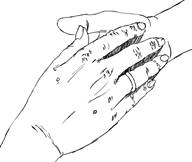renewal cycles. Complete
some now & some later.
and Get 25% off
the Total price!
Buy 3 Courses
and Get 30% off
the Total price!
Buy 4 Courses
and Get 35% off
the Total price!
| Create Account | Login | |

Section 14
Assessment Basics
Table of Contents | NCCAP/NCTRC CE Booklet
This Manual provides you with seven low-functioning activity ideas. In order to match your resident with the best activity, you need to assess his or her capability in three areas.
Start by Assessing Eye Contact
To assess the resident’s eye contact, first check to make sure you are at your resident’s eye level, in order to get eye contact from your resident. Since most residents are in wheelchairs, when you talk to them a kneeling pad is helpful. The kind of pad you would use in gardening sometimes works well. However, you can construct one of your own. Here how…
How to Make a Kneeing Pad
To construct a kneeling pad, acquire a few pieces of foam carpet pad from a carpet dealer. Fold the carpet pad four layers thick and staple the pieces together with 5 to 6 staples. The finished size of your knee pad can be about 16 x 8 inches. By kneeling on the pad, you can easily be at your resident’s eye level to maintain and assess eye contact.
Assessing Hands
Secondly, conduct a hand assessment. All seven of the activities in this Course are activities which are what I call “object manipulation.” That is, you have the resident manipulate something with his or her hands to accomplish a task. Remember, the goal of Success Therapy® is to create a feeling of success or accomplishment for your resident. For this reason, one of the most important ST® evaluations you do is an assessment of your resident’s hand movement. By doing this before you start an activity, you can establish a base line or a starting point. You can then write your observations as a Progress Note or on your Resident Assessment.
 To assess hands, ask the resident, “Would you place your hand flat in mine?” In addition to hand movement, you are assessing whether the resident can understand your simple request. If the resident does not offer his or her hand to you, ask, “Is it okay if I touch your hand?” Then gently take the resident’s hand and place it in yours; then assess if the resident has the ability to lay his or her hand flat in yours. You might comment on your resident’s hand temperature and say something like, “Your fingers feel cold. Can you close and open your hand, like this?” Then demonstrate closing and opening your hand. Make sure your demonstration is in the resident’s line of vision. For most residents, their line of vision is at a 45-degree angle to the floor.
To assess hands, ask the resident, “Would you place your hand flat in mine?” In addition to hand movement, you are assessing whether the resident can understand your simple request. If the resident does not offer his or her hand to you, ask, “Is it okay if I touch your hand?” Then gently take the resident’s hand and place it in yours; then assess if the resident has the ability to lay his or her hand flat in yours. You might comment on your resident’s hand temperature and say something like, “Your fingers feel cold. Can you close and open your hand, like this?” Then demonstrate closing and opening your hand. Make sure your demonstration is in the resident’s line of vision. For most residents, their line of vision is at a 45-degree angle to the floor.
Thumb and Index Fingers are Your Key!
Next assess the movement in your resident’s thumb and index finger of their dominant hand. You might demonstrate while asking, “Helen, can you move your hand like this?” Move your thumb and index fingers together, then apart. Once again, you are assessing your Helen’s ability to follow a simple direction. Notice if she is able to move her fingers, either upon request, or with your physical assistance. As you know, some of your residents are unable to put their thumb and index finger together because of stiff joints or lack of understanding.
If Helen appears to have the slightest ability to bring her thumb and index fingers in close proximity to each other, she may be a good candidate for a Success Therapy® Object Manipulation Activity described in this Volume.
Resident Criteria
For the Success Therapy® activities in the Course, Volume One, your resident needs to meet the following three criteria...
1. is able to have eye contact when spoken to
2. is able to bring their thumb and index finger together
3. has an attention span of at least 30 seconds.
NCCAP/NCTRC CE Booklet
Forward to Section 15
Back to Section 13
Table of Contents
Top


